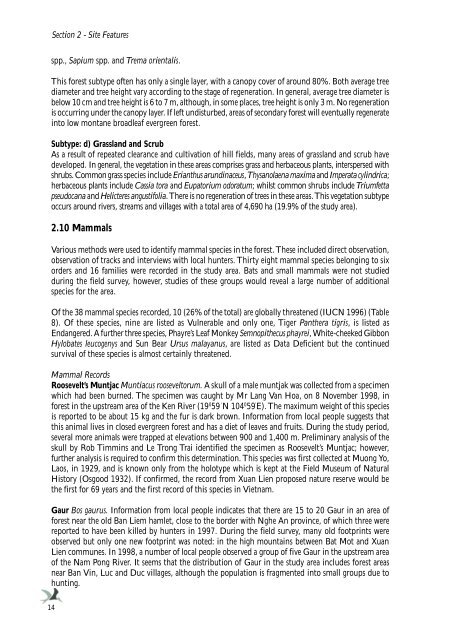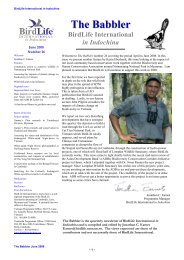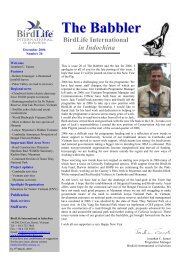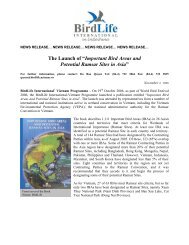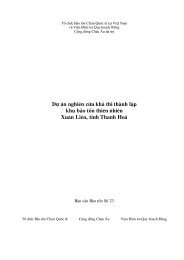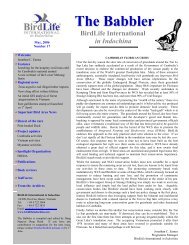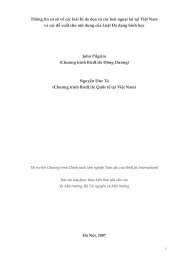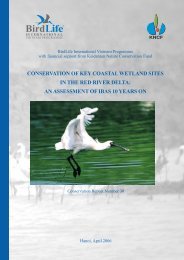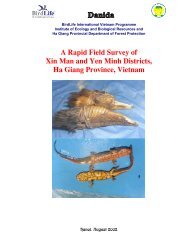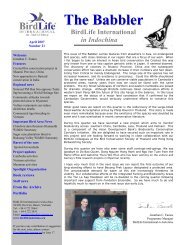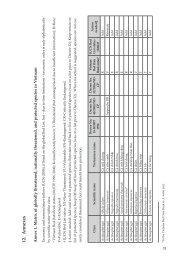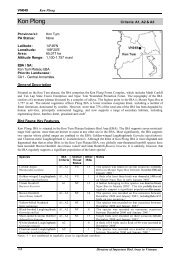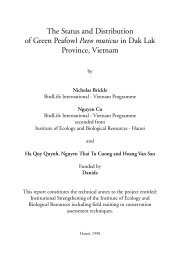A Feasibility Study for the Establishment of Xuan Lien Nature ...
A Feasibility Study for the Establishment of Xuan Lien Nature ...
A Feasibility Study for the Establishment of Xuan Lien Nature ...
Create successful ePaper yourself
Turn your PDF publications into a flip-book with our unique Google optimized e-Paper software.
Section 2 - Site Features<br />
spp., Sapium spp. and Trema orientalis.<br />
This <strong>for</strong>est subtype <strong>of</strong>ten has only a single layer, with a canopy cover <strong>of</strong> around 80%. Both average tree<br />
diameter and tree height vary according to <strong>the</strong> stage <strong>of</strong> regeneration. In general, average tree diameter is<br />
below 10 cm and tree height is 6 to 7 m, although, in some places, tree height is only 3 m. No regeneration<br />
is occurring under <strong>the</strong> canopy layer. If left undisturbed, areas <strong>of</strong> secondary <strong>for</strong>est will eventually regenerate<br />
into low montane broadleaf evergreen <strong>for</strong>est.<br />
Subtype: d) Grassland and Scrub<br />
As a result <strong>of</strong> repeated clearance and cultivation <strong>of</strong> hill fields, many areas <strong>of</strong> grassland and scrub have<br />
developed. In general, <strong>the</strong> vegetation in <strong>the</strong>se areas comprises grass and herbaceous plants, interspersed with<br />
shrubs. Common grass species include Erianthus arundinaceus, Thysanolaena maxima and Imperata cylindrica;<br />
herbaceous plants include Cassia tora and Eupatorium odoratum; whilst common shrubs include Triumfetta<br />
pseudocana and Helicteres angustifolia. There is no regeneration <strong>of</strong> trees in <strong>the</strong>se areas. This vegetation subtype<br />
occurs around rivers, streams and villages with a total area <strong>of</strong> 4,690 ha (19.9% <strong>of</strong> <strong>the</strong> study area).<br />
14<br />
2.10 Mammals<br />
Various methods were used to identify mammal species in <strong>the</strong> <strong>for</strong>est. These included direct observation,<br />
observation <strong>of</strong> tracks and interviews with local hunters. Thirty eight mammal species belonging to six<br />
orders and 16 families were recorded in <strong>the</strong> study area. Bats and small mammals were not studied<br />
during <strong>the</strong> field survey, however, studies <strong>of</strong> <strong>the</strong>se groups would reveal a large number <strong>of</strong> additional<br />
species <strong>for</strong> <strong>the</strong> area.<br />
Of <strong>the</strong> 38 mammal species recorded, 10 (26% <strong>of</strong> <strong>the</strong> total) are globally threatened (IUCN 1996) (Table<br />
8). Of <strong>the</strong>se species, nine are listed as Vulnerable and only one, Tiger Pan<strong>the</strong>ra tigris, is listed as<br />
Endangered. A fur<strong>the</strong>r three species, Phayre’s Leaf Monkey Semnopi<strong>the</strong>cus phayrei, White-cheeked Gibbon<br />
Hylobates leucogenys and Sun Bear Ursus malayanus, are listed as Data Deficient but <strong>the</strong> continued<br />
survival <strong>of</strong> <strong>the</strong>se species is almost certainly threatened.<br />
Mammal Records<br />
Roosevelt’s Muntjac Muntiacus rooseveltorum. A skull <strong>of</strong> a male muntjak was collected from a specimen<br />
which had been burned. The specimen was caught by Mr Lang Van Hoa, on 8 November 1998, in<br />
<strong>for</strong>est in <strong>the</strong> upstream area <strong>of</strong> <strong>the</strong> Ken River (19 0 59 ‘ N 104 0 59 ’ E). The maximum weight <strong>of</strong> this species<br />
is reported to be about 15 kg and <strong>the</strong> fur is dark brown. In<strong>for</strong>mation from local people suggests that<br />
this animal lives in closed evergreen <strong>for</strong>est and has a diet <strong>of</strong> leaves and fruits. During <strong>the</strong> study period,<br />
several more animals were trapped at elevations between 900 and 1,400 m. Preliminary analysis <strong>of</strong> <strong>the</strong><br />
skull by Rob Timmins and Le Trong Trai identified <strong>the</strong> specimen as Roosevelt’s Muntjac; however,<br />
fur<strong>the</strong>r analysis is required to confirm this determination. This species was first collected at Muong Yo,<br />
Laos, in 1929, and is known only from <strong>the</strong> holotype which is kept at <strong>the</strong> Field Museum <strong>of</strong> Natural<br />
History (Osgood 1932). If confirmed, <strong>the</strong> record from <strong>Xuan</strong> <strong>Lien</strong> proposed nature reserve would be<br />
<strong>the</strong> first <strong>for</strong> 69 years and <strong>the</strong> first record <strong>of</strong> this species in Vietnam.<br />
Gaur Bos gaurus. In<strong>for</strong>mation from local people indicates that <strong>the</strong>re are 15 to 20 Gaur in an area <strong>of</strong><br />
<strong>for</strong>est near <strong>the</strong> old Ban Liem hamlet, close to <strong>the</strong> border with Nghe An province, <strong>of</strong> which three were<br />
reported to have been killed by hunters in 1997. During <strong>the</strong> field survey, many old footprints were<br />
observed but only one new footprint was noted: in <strong>the</strong> high mountains between Bat Mot and <strong>Xuan</strong><br />
<strong>Lien</strong> communes. In 1998, a number <strong>of</strong> local people observed a group <strong>of</strong> five Gaur in <strong>the</strong> upstream area<br />
<strong>of</strong> <strong>the</strong> Nam Pong River. It seems that <strong>the</strong> distribution <strong>of</strong> Gaur in <strong>the</strong> study area includes <strong>for</strong>est areas<br />
near Ban Vin, Luc and Duc villages, although <strong>the</strong> population is fragmented into small groups due to<br />
hunting.


